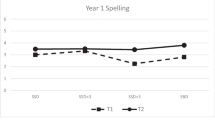Abstract
In this paper we make the case that the language of school science and the language of science are widely divergent. We trace the divergence to a simple view of reading that prevails not only in science education but in most of schooling. Based upon the importance of language in science and the role of language in capturing the essential nature of scientific reasoning, we conclude that conceiving of reading as a form of inquiry could assist in bringing the two languages more into alignment. We recommend the use of adapted primary literature as one curriculum and instruction innovation that can be useful in illustrating the nature of reading as inquiry.

Similar content being viewed by others
References
Baram-Tsabari, A., & Yarden, A. (2005). Text genre as a factor in the formation of scientific literacy. Journal of Research in Science Teaching, 42, 403–428.
Beamish, J., & Herman, T. (2003). Adsorption and desorption of helium in aerogels. Physica B, 329–333, 340–341.
Ebbers, M., & Rowell, P. (2002). Description is not enough: Scaffolding children’s explanations. Primary Science Review, 74, 10–13.
Falk, H., Brill, G., & Yarden, A. (2008). Teaching a biotechnology curriculum based on adapted primary literature. International Journal of Science Education, 30, 1841–1866.
Ford, D. J. (2005). Representations of science within children’s trade books. Journal of Research in Science Teaching, 43, 214–235.
Meldrum, A., Boatner, L. A., & Ewing, R. C. (2002). Nanocrystalline zirconia can be amorphized by ion radiation. Physical Review Letters, 88, 025503–1–025503–4.
Myers, G. (1991). Lexical cohesion and specialized knowledge in science and popular science texts. Discourse Processes, 14, 1–26.
Myers, G. (1992). Textbooks and the sociology of scientific knowledge. English for Specific Purposes, 11, 3–17.
Myers, G. (1997). Words and pictures in a biology textbook. In T. Miller (Ed.), Functional approaches to written text: Classroom applications (pp. 93–104). Paris: USIA.
Newton, D. P., & Newton, L. D. (2000). Do teachers support causal understanding through their discourse when teaching primary science? British Educational Research Journal, 26, 599–613.
Newton, L. D., Newton, D. P., Blake, A., & Brown, K. (2002). Do primary school science books for children show a concern for explanatory understanding? Research in Science & Technological Education, 20, 227–240.
Norris, S. P. (1992). Practical reasoning in the production of scientific knowledge. In R. Duschl, & R. Hamilton (Eds.), Philosophy of science, cognitive psychology, and educational theory and practice (pp. 195–225). Albany, NY: State University of New York Press.
Norris, S. P., & Phillips, L. M. (1994). Interpreting pragmatic meaning when reading popular reports of science. Journal of Research in Science Teaching, 31, 947–967.
Norris, S. P., & Phillips, L. M. (2003). How literacy in its fundamental sense is central to scientific literacy. Science Education, 87, 224–240.
Norris, S. P., & Phillips, L. M. (2008). Reading as inquiry. In R. A. Duschl, & R. E. Grandy (Eds.), Teaching scientific inquiry: Recommendations for research and implementation (pp. 233–262). Rotterdam, The Netherlands: Sense.
Norris, S. P., Phillips, L. M., & Korpan, C. A. (2003). University students’ interpretation of media reports of science and its relationship to background knowledge, interest, and reading difficulty. Public Understanding of Science, 12, 123–145.
Penney, K., Norris, S. P., Phillips, L. M., & Clark, G. (2003). The anatomy of junior high school science textbooks: An analysis of textual characteristics and a comparison to media reports of science. Canadian Journal of Science, Mathematics and Technology Education, 3, 415–436.
Phillips, L. M. (1988). Young readers’ inference strategies in reading comprehension. Cognition and Instruction, 5, 193–222.
Phillips, L. M., & Norris, S. P. (1999). Interpreting popular reports of science: What happens when the reader’s world meets the world on paper? International Journal of Science Education, 21, 317–327.
Phillips, L. M., Norris, S. P., Smith, M. L., Buker, J., & Kasper, C. (in press). Assessment techniques corresponding to scientific texts in commercial reading programs: Do they promote scientific Literacy? Alberta Journal of Educational Research.
Suppe, F. (1998). The structure of a scientific paper. Philosophy of Science, 65, 381–405.
Tenopir, C., & King, D. W. (2004). Communication patterns of engineers. Hoboken, NY: Wiley.
Wellington, J., & Osborne, J. (2001). Language and literacy in science education. Buckingham, UK: Open University Press.
Wignell, P. (1987). ‘In your own words’ Writing Project Report 1987 (Working Papers in Linguistics 5). Sydney, Australia: Department of Linguistics, University of Sydney.
Yore, L. D., Craig, M. T., & Maguire, T. O. (1998). Index of science reading awareness: An interactive-constructive model, text verification, and grades 4–8 results. Journal of Research in Science Teaching, 35, 27–51.
Author information
Authors and Affiliations
Corresponding author
Rights and permissions
About this article
Cite this article
Phillips, L.M., Norris, S.P. Bridging the Gap Between the Language of Science and the Language of School Science Through the Use of Adapted Primary Literature. Res Sci Educ 39, 313–319 (2009). https://doi.org/10.1007/s11165-008-9111-z
Received:
Accepted:
Published:
Issue Date:
DOI: https://doi.org/10.1007/s11165-008-9111-z




